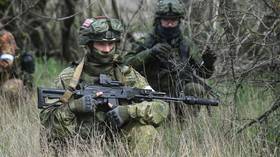BREAKDOWN: What is known about the status of Ukraine’s much-hyped ‘counteroffensive’ against Russia?

How ready is the Ukrainian army for a counter-offensive?
So far, Ukraine’s planned military assault, originally announced for November 2022, has been postponed indefinitely. Foreign sources differ in their assessment of Kiev’s readiness for a counterattack against Russia and agree that it is difficult for the Ukrainians to gather enough forces.
What is stopping the Armed Forces of Ukraine (AFU) from advancing now?
One of the main problems preventing the AFU from carrying out the announced offensive is considered to be a lack of experienced personnel.
A large portion of the combat-ready, equipped and motivated cadre units of the AFU (as well as the NGU and Territorial Defense) have already been destroyed in Mariupol, Artemovsk, Soledar, Popasnaya, Lisichansk, Severodonetsk and during the battles in the Kherson and Kharkov regions in the summer of 2022. Meanwhile, a new grouping of equal professionalism and equipment levels has not yet been formed. However, NATO and US officials differ in their estimates of the number of AFU formations.
US Defense Secretary Lloyd Austin said after the Rammstein Contact Group meeting earlier this year that Western countries had managed to prepare nine armored brigades. This figure is questionable, however, as at least 837 tanks would be needed for that size of a deployment. After Rammstein, Austin reported deliveries of 230 battle tanks, suggesting a deliberate misrepresentation of the size of the Ukrainian group.
How many reserves has the AFU built up?
Michel Goya, a French army colonel and renowned expert on modern warfare and combat innovation estimates that no more than three or four Ukrainian brigades could realistically be trained and armed by NATO and the US in the time frame allowed.
At the same time, the recently popular estimate that Ukraine had assembled 200,000 reservists looks doubtful, since in this case the AFU forces would have to exceed the combined US and NATO forces at the time of the invasion of Iraq in 2003 by 30,000-40,000 (at that time it was 160,000). The most likely figure is 80,000-100,000, which have been trained both inside and outside Ukraine since the beginning of Russia’s military operation. There is an important caveat, however. Apart from the combat experience and capabilities of the grouping, it is not clear which forces are the combat-ready vanguard and which are support units (the so-called "tooth-to-tail" ratio). If the AFU is planning an offensive like the US in Iraq, only 20,000 of the 100,000 troops assembled are actually combat-ready, the rest are support and sustainment forces.
What difficulties does the AFU face?
The conceptual problem of the offensive is the lack of surprise. AFU units are awaited from all directions – from Artemovsk to Kherson, so it is extremely difficult to surprise Russian forces in such a situation. Moreover, the movements of the Ukrainian army are well monitored, and it is almost impossible to accumulate a group of 20,000-150,000 troops unnoticed in such conditions. If they abandon massing their soldiers, and spread the forces across the front, all the advantages of large numbers are lost.
An additional difficulty is time. Delaying an offensive means not only guaranteeing the loss of Artemovsk/Bakhmut, which is being cleared at the rate of two or three blocks every 24 hours, but also disrupting the plans of foreign partners and nullifying all the financial and military aid provided so far. Moreover, every day that the AFU's offensive is delayed is an extra day for the Russian army to prepare and reinforce.
Another difficulty is the offensive reserves. Troops for an attack are divided into two types: vanguards and reserves, which are deployed at the point of the front where a breakthrough is planned. If the ground forces of the AFU are prepared for this, then the strength of any grouping in any direction can be safely divided by two. If the first wave of the AFU offensive falters, there may be no chance of a second. Repair battalions and a significant amount of reserve equipment must be ready for the offensive – this is impossible, given the total dependence on imports from the West.
Slow delivery of foreign equipment is also an issue. Although Bradley BMPs and Leopard 2 tanks are already in Ukraine, the amount of equipment is only enough to equip one or two mechanized brigades (6,000-7,000 men). The rest will receive light armored vehicles whose survivability in a high-intensity conflict is minimal.
Further, deliveries of Western air defense systems, essential to any major offensive, are either severely delayed, only arriving in the form of Stinger and Starstreak man-portable air defense systems, or in the form of short-range SAMs such as the Avenger and Stormer HMVs.
The main technical difficulty is the lack of significant numbers of attack aircraft and air superiority. Yes, the Ukrainian air defense system is still in place and functioning, but the stationary air defense systems are getting worse at dealing with missile attacks and cannot be re-assigned for the offensive. The number of operational fighters and attack aircraft in the Ukrainian Air Force is unknown, but a significant proportion of these could be shot down by the Russian Air Force at the start of the operation.
What if the AFU does not stage a counteroffensive now?
The AFU attack is likely to be postponed to a later date, by which time both equipment and men will have gathered in sufficient numbers. In addition, the weather is forcing adjustments – it makes no sense to advance in rainy and muddy conditions. The results of reckless attempts to attack are clearly visible in Artemovsk, where most of the roads are littered with wrecked AFU equipment.














